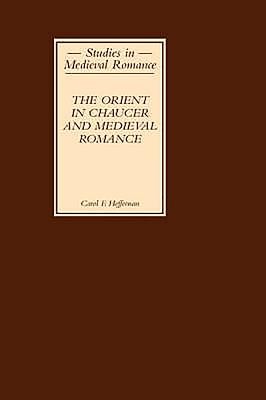
- We will send in 10–14 business days.
- Author: Carol F Heffernan
- Publisher: Boydell & Brewer
- ISBN-10: 0859917959
- ISBN-13: 9780859917957
- Format: 16.2 x 24.9 x 1.7 cm, hardcover
- Language: English
- SAVE -10% with code: EXTRA
Reviews
Description
A study of romance and the Orient in Chaucer and in anonymous popular metrical romances.
The idea of the Orient is a major motif in Chaucer and medieval romance, and this new study reveals much about its use and significance, setting the literature in its historical context and thereby offering fresh new readings of anumber of texts. The author begins by looking at Chaucer's and Gower's treatment of the legend of Constance, as told by the Man of Law, demonstrating that Chaucer's addition of a pattern of mercantile details highlights the commercial context of the eastern Mediterranean in which the heroine is placed; she goes on to show how Chaucer's portraits of Cleopatra and Dido from the Legend of Good Women, read against parallel texts, especially in Boccaccio, reveal them to be loci of medieval orientalism. She then examines Chaucer's inventive handling of details taken from Eastern sources and analogues in the Squire's Tale, showing how he shapes them into the western form ofinterlace. The author concludes by looking at two romances, Floris and Blauncheflur and Le Bone Florence of Rome; she argues that elements in Floris of sibling incest are legitimised into a quest for the beloved, and demonstrates that Le Bone Florence be related to analogous oriental tales about heroic women who remain steadfast in virtue against persecution and adversity. Professor CAROL F. HEFFERNAN teaches in the Department ofEnglish, Rutgers University.EXTRA 10 % discount with code: EXTRA
The promotion ends in 18d.16:58:35
The discount code is valid when purchasing from 10 €. Discounts do not stack.
- Author: Carol F Heffernan
- Publisher: Boydell & Brewer
- ISBN-10: 0859917959
- ISBN-13: 9780859917957
- Format: 16.2 x 24.9 x 1.7 cm, hardcover
- Language: English English
A study of romance and the Orient in Chaucer and in anonymous popular metrical romances.
The idea of the Orient is a major motif in Chaucer and medieval romance, and this new study reveals much about its use and significance, setting the literature in its historical context and thereby offering fresh new readings of anumber of texts. The author begins by looking at Chaucer's and Gower's treatment of the legend of Constance, as told by the Man of Law, demonstrating that Chaucer's addition of a pattern of mercantile details highlights the commercial context of the eastern Mediterranean in which the heroine is placed; she goes on to show how Chaucer's portraits of Cleopatra and Dido from the Legend of Good Women, read against parallel texts, especially in Boccaccio, reveal them to be loci of medieval orientalism. She then examines Chaucer's inventive handling of details taken from Eastern sources and analogues in the Squire's Tale, showing how he shapes them into the western form ofinterlace. The author concludes by looking at two romances, Floris and Blauncheflur and Le Bone Florence of Rome; she argues that elements in Floris of sibling incest are legitimised into a quest for the beloved, and demonstrates that Le Bone Florence be related to analogous oriental tales about heroic women who remain steadfast in virtue against persecution and adversity. Professor CAROL F. HEFFERNAN teaches in the Department ofEnglish, Rutgers University.

Reviews